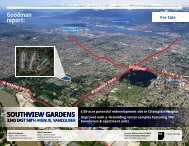Canada
MER-Canada-2016
MER-Canada-2016
You also want an ePaper? Increase the reach of your titles
YUMPU automatically turns print PDFs into web optimized ePapers that Google loves.
CHAPTER 6. SUPERVISION<br />
Risk-based supervision of compliance with AML/CTF requirements<br />
252. The regulatory regime involves both federal and provincial supervisors. FINTRAC is<br />
responsible for supervising all FIs and DNFBPs for compliance with their AML/CFT obligations<br />
under the PCMLTFA. Other supervisors may incorporate AML/CFT aspects within their wider<br />
supervisory responsibilities although the assessment team found that in instances where an<br />
AML/CFT issue arose, the primary regulator would refer the issue to FINTRAC. Given the primary<br />
responsibility held by FINTRAC for all REs and the federal and provincial division of powers for<br />
financial supervision other than in the areas of AML/CFT, combined with the geographical spread of<br />
the Canadian regulatory regime, the assessment team focused primarily on FINTRAC and OSFI’s<br />
supervisory regime, but also met with provincial supervisors (e.g. AMF in Quebec) and other<br />
supervisors (e.g. IIROC for investment dealers).<br />
6<br />
253. FINTRAC has increased its resources and the level of sophistication of its compliance and<br />
enforcement program (“supervisory program”) in recent years. In 2014/2015, there was 79 full-time<br />
staff employed in FINTRAC’s supervisory program. Of this, 57 staff members were involved in direct<br />
enforcement activities including outreach and engagement (10), reports monitoring (5),<br />
examinations (37), and AMPs/NCDs (5). It has also developed, and continues to develop, its<br />
supervisory capabilities on a RBA. Its understanding of the different sectors and business models<br />
and of how AML/CFT obligations apply taking into account materiality and context is somewhat<br />
limited. This was communicated to the assessors by REs in the banking and real estate sectors<br />
during the on-site visit. FINTRAC has nevertheless increased its understanding of its different<br />
reporting sectors which is a challenge given the large number and diverse range of entities it<br />
supervises.<br />
254. A range of supervisory tools is used by FINTRAC to discharge its supervisory<br />
responsibilities and, for the most part, those tools are applied consistently with the risks identified. A<br />
case management tool determines the level and extent of supervision to be applied to sectors and<br />
individual REs scoping specific areas for examinations, recording supervisory findings and managing<br />
follow-up activities. High-risk sectors are subject to on-site and desk examinations (details of which<br />
are contained in this report). Less intensive supervisory tools are used for lower-risk sectors. These<br />
tools include self-assessment questionnaires (Compliance Assessment Reports or CARs);<br />
observation letters (setting out deficiencies that require action); Voluntary Self Declarations of Non-<br />
Compliance (VSDONC); and policy interpretations on specific issues that require clarification. The<br />
use of observation letters was piloted with the caisses populaires sector in 2013/2014. FINTRAC had<br />
identified that caisses populaires were reporting large cash transactions of more than CAD 10 000<br />
through automated teller machines which was not possible given the low limit on transactions<br />
through such machines. Observation letters were used to correct a misinterpretation of reporting<br />
obligations and clarify the correct way to report these types of transactions. FINTRAC also uses<br />
outreach tools for lower-risk sectors assistance and awareness building tools among smaller REs<br />
with limited resources, compliance experience and works with industry representatives. While<br />
supervisory measures are generally in line with the main ML/TF risks, more intensive supervisory<br />
measures should be applied in higher risk areas such as the real estate and DPMS sectors. FINTRAC<br />
Anti-money laundering and counter-terrorist financing measures in <strong>Canada</strong> - 2016 © FATF and APG 2016<br />
91




